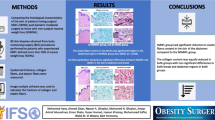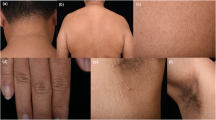Abstract
Background
Bariatric surgery, despite its beneficial effects, is responsible for highly frequent wound healing complications, as it has already been demonstrated in post-biliopancreatic diversion (BPD) patients.
The aim of this study was to analyze results and wound healing process in a population submitted to Roux-en-Y gastric bypass (RYGB), a procedure involving both a malabsorptive and restrictive approach.
Methods
Thirteen non-smokers and non-diabetic patients submitted to laparoscopic RYGB underwent abdominoplasty. Biochemical parameters before and after bariatric surgery were evaluated. The content of total protein and hydroxyproline (revealing collagen amount) was assessed in multiple biopsies before and after RYGB. Skin samples were subjected to macroscopic and histological evaluation, where elastic fibers content was put into evidence by a specific stain (Wigert–Van Gieson).
Results
Most of the biochemical parameters analyzed showed a mild reduction after weight loss surgery. Neither tissue proteins nor hydroxyproline were significantly reduced after RYGB. Macroscopically, equal thickness of the two adipose tissue layers (areolar and lamellar) was observed in addition to normal consistency and compactness. Histological evaluation revealed fibroblast augmentation, hypertrophic adipocytes, and augmented dimension. Results were then compared with those previously obtained in post-BPD population.
Conclusion
Despite that further elaborations are needed, RYGB, compared to BPD, seems to be associated with minor modifications of tissues and biochemical and tissue parameter values, possibly leading to a lower wound complication rate.
Level of Evidence: Level IV, prognostic study


Similar content being viewed by others
References
Pierpont YN, Dinh TP, Salas RE, et al (2014) Obesity and surgical wound healing: a current review. ISRN Obes. doi:10.1155/2014/638936
Van der Beek ES, Van der Molen AM, van Ramshorst B (2011) Complications after body contouring surgery in post-bariatric patients: the importance of a stable weight close to normal. Obes Facts 4(1):61–66
Aasheim ET (2008) Wernicke encephalopathy after bariatric surgery: a systematic review. Ann Surg 248(5):714–720
D'Ettorre M, Gniuli D, Iaconelli A et al (2010) Wound healing process in post-bariatric patients: an experimental evaluation. Obes Surg 20(11):1552–1558
Tambasco D, D'Ettorre M, Gentileschi S et al (2014) Postabdominoplasty wound dehiscence in bariatric patients: biliopancreatic diversion versus gastric bypass: a preliminary study. Ann Plast Surg. doi:10.1097/SAP.0000000000000195
Banka G, Woodard G, Hernandez-Boussard T et al (2012) Laparoscopic vs open gastric bypass surgery: differences in patient demographics, safety, and outcomes. Arch Surg 147(6):550–556
Bracaglia R, D'Ettorre M, Gentileschi S et al (2012) "Vest over pants abdominoplasty" in post-bariatric patients. Aesthetic Plast Surg 36:23–27
Bracaglia R, Tambasco D, D’Ettorre M et al (2012) “Inverted Y”: a modified vest-over-pants abdominoplasty pattern following bariatric surgery. Aesthetic Plast Surg 36:1179–1185
Jorgensen LN, Olsen L, Kallehave F et al (1995) The wound healing process in surgical patients evaluated by the expanded polytetrafluoroethylene and the polyvinyl alcohol sponge: a comparison with special reference to intrapatient variability. Wound Repair Regen 3:527–532
Pearse AGE (1960) p. 165–75, p. 582–3, p. 816, p. 820–1 Histochemistry, theoretical and applied, 2nd edn. Little Brown, Boston
Drury RAB, Wallington EA, Camerson R (1966) Carleton's histological technique, 4th edn. Oxford University Press, Oxford
D’Ettorre M, Gniuli D, Bracaglia R et al (2013) Dermal histomorphology in Postbariatric patients: Bilopancreatic diversion versus gastric bypass. Ann Plast Surg 71:441–442
Araco A, Gravante G, Araco F et al (2006) Body contouring after weight loss: the plasticbariatric surgery symbiosis. Aesthetic Plast Surg 30:374–376
Borud LJ, Warren AG (2006) Body contouring in the postbariatricsurgery patients. J Am Coll Surg 203:82–93
Knoetgen J III, Petry PM, Johnson CH (2005) Plastic surgery after bariatric surgery and massive weight loss. Mayo Clin Proc 80:136
Vastine VL, Morgan RF, Williams GS et al (1999) Wound complications of abdominoplasty in obese patients. Ann Plast Surg 42:34–39
Shermak MA, Chang D, Magnuson TH et al (2006) An outcomes analysis of patients undergoing body contouring surgery after massive weight loss. Plast Reconstr Surg 118:1026–1031
D'Ettorre M, Gniuli D, Bracaglia R et al (2012) Micro- and macroscopic structural modification of subcutaneous adipose tissue after bariatric surgery. Aesthetic Plast Surg 36:213–214
D'Ettorre M, Bracaglia R, Gentileschi S et al (2013) Micro- and macroscopic tissue modifications after bariatric surgery: bilio-pancreatic diversion vs gastric bypass. Aesthetic Plast Surg 37:846–848
Momeni ABarbour JR, Iorio ML, Oh C, Tung TH, O'Neill PJ (2014) Predictive value of nutritional markers for wound healing complications in bariatric patients undergoing panniculectomy. Ann Plast Surg. doi:10.1097/SAP.0000000000000188
Fearmonti RM, Blanton M, Bond JE et al (2012) Changes in dermal histomorphology following surgical weight loss versus diet-induced weight loss in the morbidly obese patient. Ann Plast Surg 68(5):507–512
Shermak MA, Mallalieu J, Chang D (2010) Do preexisting abdominal scars threaten wound healing in abdominoplasty? Eplasty 10:e14
Neaman KC, Hansen JE (2007) Analysis of complications from abdominoplasty. Ann Plast Surg 58:292–298
Author information
Authors and Affiliations
Corresponding author
Ethics declarations
Funding
None.
Conflicts of interest
Marco D'Ettorre, Damiano Tambasco, Geltrude Mingrone and Roberto Bracaglia declare they have no conflicts of interest.
Ethical approval
All procedures performed in studies involving human participants were in accordance with the ethical standards of the institutional and/or national research committee and with the 1964 Helsinki Declaration and its later amendments or comparable ethical standards.
Patient consent
Patient consent was obtained from all individual participants included in the study.
Rights and permissions
About this article
Cite this article
D’Ettorre, M., Tambasco, D., Mingrone, G. et al. Predictive value of biochemical and tissue modifications for wound healing in post-bariatric patients. Eur J Plast Surg 40, 549–554 (2017). https://doi.org/10.1007/s00238-017-1290-2
Received:
Accepted:
Published:
Issue Date:
DOI: https://doi.org/10.1007/s00238-017-1290-2




